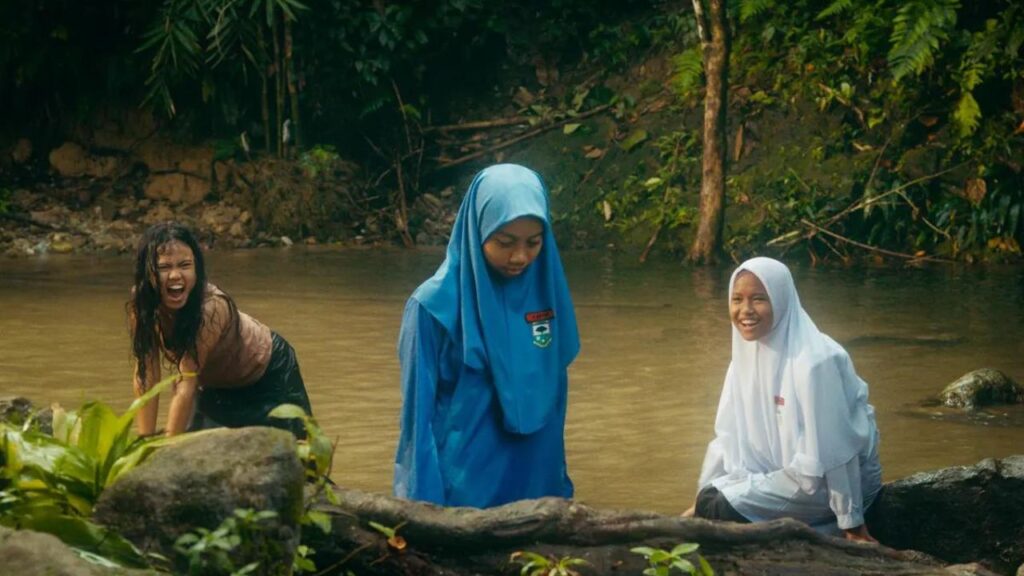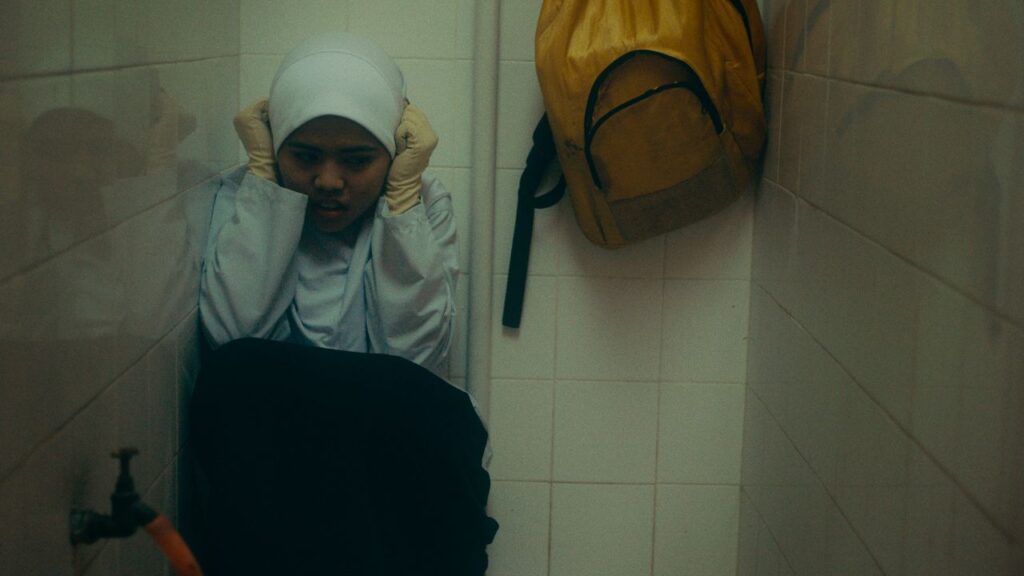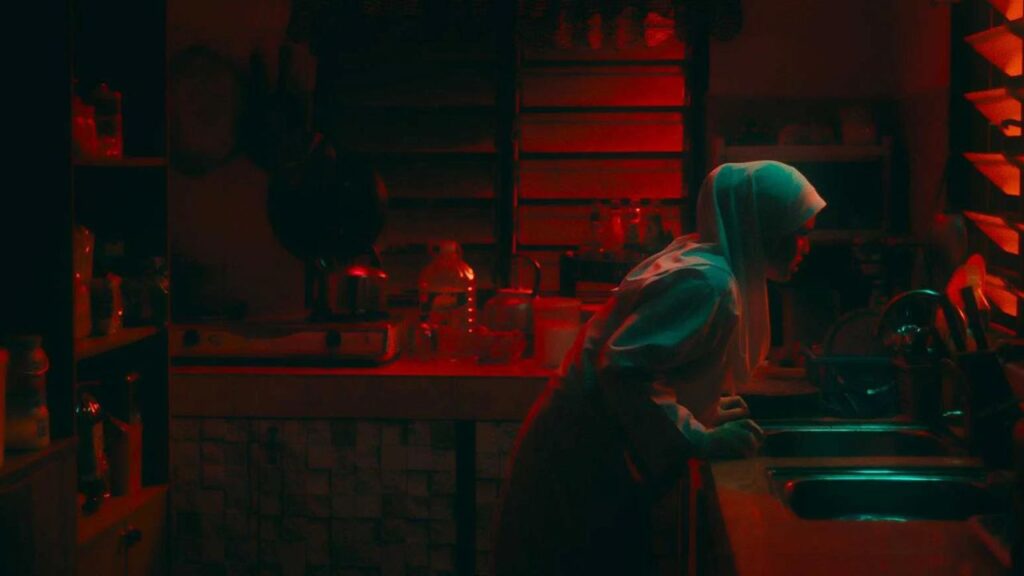That time of the month. Menses. Aunty visiting. “Cuti.”
Whatever the euphemism that pops up to describe a period — and there are 5,000 of them, apparently — the historical reason for it is clear. It’s a topic full of shame. While the conversations surrounding it have been shifting since the late 2010s — for maybe most of the world, women’s and girls’ natural menstrual cycle is still a taboo topic. Something to be hidden away and stigmatized, something only discussed with contempt. Or worse, disgust.
Amanda Nell Eu’s Tiger Stripes resides within that taboo. The story’s catalyst is that Zaffan gets her period, beginning her transformation into a supposed “woman” – or monster, which is one and the same in this film. As much as she tries to hide it, the chaos it brings catches the attention of not only her old friends turned bullies, but also her whole village. Perhaps most ironically, the story of the film mirrors the controversy surrounding the Malaysian cinematic release; only serving to magnify how the metaphor and symbolism in Tiger Stripes isn’t all that different from our everyday reality.

From the beginning, periods are quickly established as something “dirty.” Even the saying Zaffan’s mother uses to describe it “datang kotor,” literally means she’s become dirty. With it, there are changes in her body that she, nor anyone else in her life, can understand. She develops gnarly rashes along her body and grows whiskers. The girls who were once her friends turn into her bullies, calling her “gross,” and “weird,” as well as commenting on her smell — shaming her for the puberty they ignore that they’ll have to go through as well.
Due to this transformation, there’s a marked change in Zaffan’s character compared to the start of the film. Her vigour and rebelliousness from the beginning of the film are replaced with obedience and quiet. The girl who was once brought on stage for bad behaviour turns into a model student and joins the girl scouts.
Zaffan makes a point to quite literally censor herself to try and hide from the devious allegations, to cover up her burgeoning woman/monsterhood and maybe rekindle her friendships again. She doesn’t even take off her hijab or gloves (at least until she’s forced to) — there are only hints of her worsening condition revealed when she’s alone. It’s a stark difference from her coming home in her underclothes and taking off her hijab any chance she was given. If she’s that good of a student and young lady, she can’t be “gross” anymore, right?

But, like any classic case of the Streisand Effect, the more Zaffan hides the monstrous parts of herself, the more it forces even more eyes on her. Even her mother asks her to take off her gloves at home complaining that she’s being silly for wearing them around the house. At the climax of the film, she is cornered in the bathroom and her bullies ask to see the same period that they deemed “disgusting” beforehand. While being tormented and having her privacy violated, Zaffan is filmed by some of the girls, which snowballs into a larger spectacle when the reveal of her transformation triggers mass hysteria.
The fanfare causes Dr. Rahim, a snake oil exorcist, to visit the school, in an attempt to find the source of the disturbance in their village. This only causes the issue to become more public. Being a social media star, he films helping some of the girls who are affected (which brings some very questionable implications in his exploitation of their pain) and eventually, he’s brought in to exorcise Zaffan. When she doesn’t take to his demands, he quite harrowingly physically assaults her, mirroring far too real attitudes towards girls and women who don’t obey patriarchal expectations of them. Ultimately, when she accepts her monstrous self — fully turning into a human-tiger hybrid — she’s treated exactly like the tiger seen in a social media video earlier: followed from a distance with a fearful, watchful eye.

It’s then clear to see how the plot of Tiger Stripes reflects the controversy of its Malaysian theatrical release. Censored to the point of disownment, the missing story provides clear and important building blocks to Zaffan’s character and relatable parts of her girlhood. Eu herself describes the cut scenes as showing “the very joy of being a young girl in Malaysia” in an Instagram post about the censorship. Pulling apart those scenes, implicitly giving them explicit labels, only serves to place the real experiences of young girls as unspeakable, dirty things, and ultimately punishing them for ever doing things like that.
No coverage was spared about the disownment either. From The Star to Deadline, national and international news publications covered Eu’s statement, bringing to question the levels of censorship needed for a film like this. Cannes Critics Week accolades aside, at what point does an age rating become redundant and where does that place Malaysian cinema if we’re not willing to explore important themes, even if they’re uncomfortable? Ironically enough, the censorship saga mirrors the attitude of Zaffan’s mother within the film, punishing her daughter for walking home without her baju kurung so harshly that it gets the attention of their neighbours.
Ultimately, in the case of Tiger Stripes, the saying that cinema brings a mirror up to society is true in more ways than one. A girl erring on the edge of womanhood is dangerous and alluring, something people speak about in hushed tones and want to see in secret, but simultaneously condemn in public. In its exploration of the realities of girlhood and taboo through the medium of horror and fantasy, it was butchered, covered up, and then paraded for consumption. When really, all we need to do is just let girls be girls — just like Zaffan dancing at the end, finally carefree and happy – even if she is a monster.








